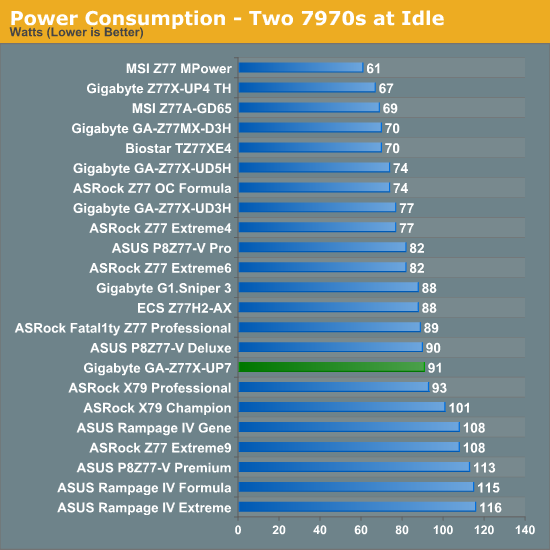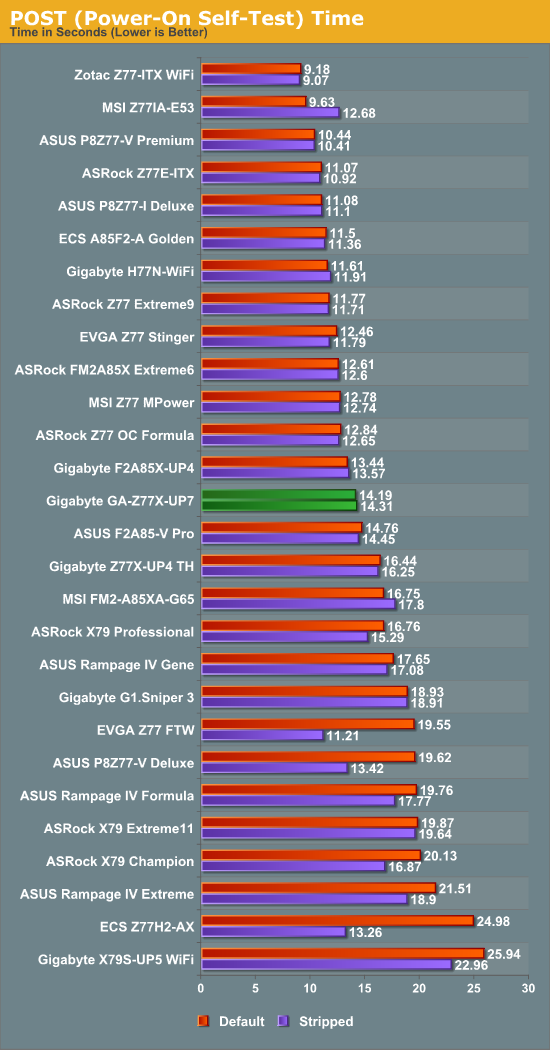Gigabyte Z77X-UP7 Review: OC Oriented Orange Overkill
by Ian Cutress on March 1, 2013 10:30 AM EST- Posted in
- Motherboards
- Intel
- Gigabyte
- Z77
Many thanks to...
We must thank the following companies for kindly donating hardware for our test bed:
Thank you to OCZ for providing us with the 1250W Gold Power Supply and USB testing SSD
Thank you to Micron for providing us with the SATA SSD
Thank you to G.Skill for providing us with the memory kits
Thank you to ASUS for providing us the AMD GPUs and some IO Testing kit
Thank you to ECS for providing us the NVIDIA GPUs
Test Setup
| Test Setup | |
| Processor |
Intel Core i7-3770K Retail 4 Cores, 8 Threads, 3.5 GHz (3.9 GHz Turbo) |
| Motherboards |
ASRock Z77 Extreme4 ASRock Z77 Extreme6 ASRock Z77 Extreme9 ASRock Z77 OC Formula ASRock Fatal1ty Z77 Professional ASUS P8Z77-V Pro ASUS P8Z77-V Deluxe ASUS P8Z77-V Premium Biostar TZ77XE4 ECS Z77H2-AX EVGA Z77 FTW Gigabyte GA-Z77X-UD3H Gigabyte GA-Z77X-UD5H Gigabyte GA-Z77MX-D3H Gigabyte G1.Sniper 3 Gigabyte GA-Z77X-UP4 TH Gigabyte GA-Z77X-UP7 MSI Z77 MPower MSI Z77A-GD65 |
| Cooling | Thermalright TRUE Copper |
| Power Supply | OCZ 1250W Gold ZX Series |
| Memory |
GSkill RipjawsZ 4x4 GB DDR3-2400 9-11-11 Kit GSkill TridentX 2x4 GB DDR3-2666 11-13-13 Kit |
| Memory Settings | XMP (2400 9-11-11) |
| Video Cards |
ASUS HD7970 3GB ECS GTX 580 1536MB |
| Video Drivers |
Catalyst 12.3 NVIDIA Drivers 296.10 WHQL |
| Hard Drive | Micron RealSSD C300 256GB |
| Optical Drive | LG GH22NS50 |
| Case | Open Test Bed - CoolerMaster Lab V1.0 |
| Operating System | Windows 7 64-bit |
| USB 2/3 Testing | OCZ Vertex 3 240GB with SATA->USB Adaptor |
Power Consumption
Power consumption was tested on the system as a whole with a wall meter connected to the OCZ 1250W power supply, while in a dual 7970 GPU configuration. This power supply is Gold rated, and as I am in the UK on a 230-240 V supply, leads to ~75% efficiency > 50W, and 90%+ efficiency at 250W, which is suitable for both idle and multi-GPU loading. This method of power reading allows us to compare the power management of the UEFI and the board to supply components with power under load, and includes typical PSU losses due to efficiency. These are the real world values that consumers may expect from a typical system (minus the monitor) using this motherboard.
While this method for power measurement may not be ideal, and you feel these numbers are not representative due to the high wattage power supply being used (we use the same PSU to remain consistent over a series of reviews, and the fact that some boards on our test bed get tested with three or four high powered GPUs), the important point to take away is the relationship between the numbers. These boards are all under the same conditions, and thus the differences between them should be easy to spot.

The Z77X-UP7 is stuck between a rock and a hard place on power usage. The IR3550s it uses are very efficient for power, but having 32 on the board (and 8 working at idle) causes a little more power usage than the other OC boards across our range of tests.
POST Time
Different motherboards have different POST sequences before an operating system is initialized. A lot of this is dependent on the board itself, and POST boot time is determined by the controllers on board (and the sequence of how those extras are organized). As part of our testing, we are now going to look at the POST Boot Time - this is the time from pressing the ON button on the computer to when Windows starts loading. (We discount Windows loading as it is highly variable given Windows specific features.) These results are subject to human error, so please allow +/- 1 second in these results.

Boot time for the UP7 does not touch our artificial ‘sub-12 second’ ideal line, but at 14 seconds is the fasted Gigabyte Z77 board we have tested.










41 Comments
View All Comments
Beenthere - Saturday, March 2, 2013 - link
Don't be concerned about the $400 entry fee to the Pumpkin fanbois club, as there are quite a few kids able to spend Mommy's money on impractical toys. Asus has proved that there are many PC enthusiast suckers born every minute so Gigabyte might as well cash in on the technically dumbness, too.CeriseCogburn - Sunday, March 3, 2013 - link
With the amount of technically challenged I see here at Anand that proclaim otherwise I don't believe it has anything to do with hype for pretty colors or expensive items.Most people don't have a clue, a few have a bit, and those that do keep learning, it doesn't relate to pocketbook depth or how money is "foolishly spent", or how jealous the poorboy crybabies are when others buy the best of the best, as your personal life experience should tell you.
Without extravagant waste widespread the world would still be a 3rd world dirtbag hole, everywhere.
Pretty sick of the new crybaby constant whines - if the group of whackos isn't squealing penny pinch bang for the buck, they're whining about top end items.
I think we need a new "computer blog law" or two in order to outline the pervasive complaint themes that have become popular.
Uber_Roy - Wednesday, March 6, 2013 - link
LoL give this man a prize funnest shit i seen in a while :Pehume - Saturday, March 2, 2013 - link
And now we seem to be able to survey the field. So, looking down from this height, what would you recommend for someone who wants to get the highest overclock from a 3770k, using the lowest Voltage (thus producing the lowest temps) and doesn't do any gaming?Sniper boards seem unnecessarily fancy, with too much emphasis on GPU's. The ASRock Z77 Extreme6 or Extreme4 seem OK, but maybe not great. Somewhere between those ends is a sweet middle spot for a simple overclocker.
Given a year of Ivy Bridge, what would you recommend?
C.C. - Saturday, March 2, 2013 - link
The ASROCK Extreme4 would work perfectly for your needs! I have done several builds using the Extreme 4 and I 3770Ks. They are simply the best bang for the buck motherboard. You get all the features you need, at an awesome price. I am currently running an i7 3770K with the IHS removed (aka de-lidded) @ 4.8Ghz @ 1.272V..I have run a 48hr Prime95 stress test, and with watercooling and CL Liquid Ultra TIM, max core temps are 45,43,53,and 44C. The CL ultra is amazing, it doubled my thermal gains from de-lidding. I was using IC Diamond, and max temps were 74,73,85,and 75C.CeriseCogburn - Sunday, March 3, 2013 - link
I agree they have been pushing out some great deals for some time, although there are other brands that do well at good prices too.(I don't quibble about $5, $10, $20, $30, or $50 bucks)
IanCutress - Sunday, March 3, 2013 - link
I would never suggest aiming for the highest overclock from a CPU to run in a 24/7 machine. Find the best, then dial it back a few notches so you hit a sweet spot in terms of performance/power usage/temperatures.Ivy Bridge CPUs can vary so much, where one CPU off the shelf could take 0.1 volts less than another to hit the same clocks. For a 24/7 system, I would rather go with a motherboard that makes it easy to overclock to a nice speed rather than one that necessarily does the best. And what is the best motherboard? It's hard to tell - every CPU curve is different - is the best board one that could take a mediocre processor to new heights, or one that has the ultimate capacity to take the most expensive and best CPUs to the top in terms of performance?
Then it all comes down to price. The ASRock Z77 OC Formula, ASUS P8Z77-V Pro and GIgabyte Z77X-UD5H are all around the $210 (+/- $30) mark that will happily take a good Ivy Bridge processor to 4.8 GHz. I still have the ASUS Maximus V Formula and Gene to review shortly, as well as the G1.Sniper M3.
CeriseCogburn - Sunday, March 3, 2013 - link
LOL, good luck at the OC'ing tunaman.stren - Tuesday, March 5, 2013 - link
If you're repeating the gaming benchmarks then let's stress the PLX chip next time - 4xCF won't do that:- Use Nvidia cards because they use a ton more pci-e bw than the amd cards
- Preferably 3/4xTitans or 4x 680s as they have the most potential to be pci-e limited
- Run at super high resolutions. E.g. 3x1080p minimum, preferably 3x1440p.
This is where vega saw pcie bw issues really show up. A good comparison would be versus the R4E and the Asrock X11. I.E. native 8x8x8x8x vs PLX 8x8x8x8x vs 2xPLX 16x16x16x16x However as both those boards are x79 though I would suggest just maxing out the cpu clock rather than equalizing it as this is more fair and representative of what the high end users would do.
iamkyle - Thursday, March 7, 2013 - link
There is one thing I loved about the previous iteration of this board being the X58A-OC - the minimalist I/O panel. Although it didn't go far enough in my opinion, it was a delight to behold.The whole bit about the enthusiast community is customization - the ability to change out whatever setups they want in regards to video, ram, cooling, you name it. But yet the manufacturers still continue to force choices in sub-par audio codecs and NIC choices.
The ideal enthusiast board should be devoid of of any excess I/O outside of USB ports. I should be able to put in my audiophile-grade sound card, enterprise-class NIC, what have you without the extras being thrown in. That is true choice.